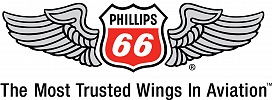Technical Glossary
Customer trust is built by showing competence and credibility, which means demonstrating a thorough understanding of your customer’s equipment needs. As you know, proper lubrication is a critical component of any regular maintenance program. To help refresh you on terminology that may affect you or your customers’ lubricants decisions, Phillips 66 has developed the following glossary:
GLOSSARY TERMS:
Additives:
Any compound added to oil for the purpose of improving certain properties of the oil.
Approved Aviation Oil:
Approved Aviation Oil is any brand name oil produced under the following specifications:
• Mineral Grades – SAE J1966 or MIL-L-6082 (obsolete) – This SAE Standard establishes the requirements for non-dispersant, mineral lubricating oils to be used in four -stroke cycle piston aircraft engines. Users should consult their airframe or engine manufacturer’s manuals for the latest listing of acceptable lubricants.
• Ashless Dispersant Grades – SAE J1899 or MIL-L-22851 (obsolete) – This SAE Standard establishes the requirements for lubrication oils containing ashless dispersant additives to be used in four stroke cycle, reciprocating piston aircraft engines. Users should consult their airframe or engine manufacturer’s manuals for the latest listing of acceptable lubricants.
CAUTION: Some approved oils contain anti-scuffing additives that should NOT be used during engine break-in. Always refer to the label to ensure that the oil is correct for your application.
Ashless:
When burned, does not form a metallic ash, which could be a source of pre-ignition.
Ashless Dispersant (AD):
A cleanliness additive for engine oils and widely used in aviation piston engines. Ashless dispersants do not contain metallic compounds and have no adverse affect on the break-in process. (See also “Dispersant”)
Boundary Lubrication:
A condition which occurs when the two surfaces are not completely separated by the lubricant. Boundary lubrication often requires the use of EP additives.
Detergent:
A cleanliness additive made of metallic compounds to protect from sludge and varnish build-ups. Detergents are not allowed in aviation piston engine oils qualified under SAE J-1899 (obsolete MIL-L-22851) or SAE J-1966 (obsolete MIL-L-6082).
Note: No current aviation engine oil meeting the SAE J-1899 specification contains detergent compounds.
Dispersant:
An ashless engine oil additive that helps prevent sludge, varnish and other engine deposits by breaking up insoluble contaminant particles. These microscopic particles are kept suspended (or “dispersed”) in the oil so they can be carried to the oil filter or until the oil is drained when no filter is installed.
Hydrodynamic Lubrication:
A system of lubrication in which the shapes and relative motion of the sliding surfaces cause the formation of a full fluid film that has enough pressure to separate the surfaces.
Micron (μm):
A unit of measure = 4 x 10-5 inches. (or 1 millionth of a meter). It is used to measure oil film thickness and is also useful in specifying oil filter capabilities.
Mineral Oil:
Lubricating base oil distilled from crude oil; also a term used to distinguish it from synthetic base oils. In aviation circles, this typically refers to un-additized oil often used to break-in new or newly rebuilt piston engines.
Multiviscosity:
Engine oil that meets the requirements of more than one SAE viscosity grade classification by passing tests at both high and low temperatures. Viscosity Index (VI) improvers are employed and the designation “W” indicates winter grade.
Note: Multiviscosity aviation piston engine oils have the advantage of quicker pumping at start-up, faster flow to the upper valve train, reduced strain on the battery and starter, and a thicker oil film at high temperatures versus straight grades.
SAE Grade:
System used by engine manufacturers to define the lubricating oil viscosity requirements for their engines.
SAE Viscosity vs. MIL Grade:
| SAE Viscosity |
MIL Aviation Grade |
|
30 |
65 |
|
40 |
80 |
|
50 |
100 |
|
60 |
120 |
Scuffing:
Severe adhesive wear resulting from metal transferring from one surface to a mating surface due to solid phase welding or abrasive effects between sliding surfaces.
Sludge:
A coagulated mass, often containing foreign matter, formed at low temperature in piston engines from oil oxidation residues, carbon and water.
Synthetic Oil:
Lubricating fluid made by chemically reacting materials of a specific chemical composition to produce a compound with planned and predictable properties.
Note: Full synthetics have been unsuccessful in aviation piston engines due to incompatibility with leaded fuel. Synthetic blends are sometimes used. However, we have not found these to be of similar added value (cost vs. performance) in aviation piston engines as they are in automotive or heavy duty trucking applications.
TCP:
Tricresyl Phosphate or Triphenyl Phosphate. An oil additive which acts as an anti-scuff agent in a lubricant or a lead-scavenger when used as a fuel additive. This property in a lubricant is called for with specific Lycoming engines which require the use of LW-16702. (See also “Scuffing”)
VI Improver:
Viscosity Index Improvers are chemical polymers which expand with increasing temperature to counteract oil thinning. The higher the Viscosity Index, the smaller the relative change in viscosity with temperature.
Viscosity:
Measure of liquid resistance to flow at a specific temperature.
W (e.g. 20W-50):
Grade numbers followed by the letter “W” (i.e. 5W-, 10W-, etc.) identify oils suitable for winter service. Viscosities for those oils are determined at various cold temperatures on a laboratory Cold Cranking Simulator (CCS) and Mini Rotary Viscometer (MRV). Numbers without the W (i.e. 50, 60, etc.) identify oils which are tested at high temperature only. (See also “Multiviscosity”)

